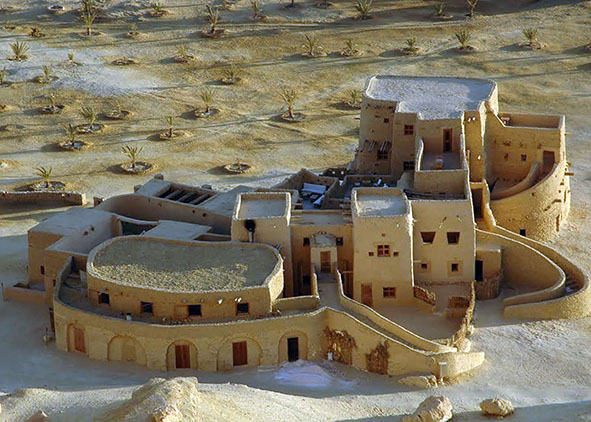Indications for low-cost sustainability in Egyptian residential construction
DOI:
https://doi.org/10.19229/2464-9309/6172019Keywords:
affordable sustainability, housing sector, vernacular materials, environmental awareness, CairoAbstract
Although sustainable building techniques and materials have always been used in the residential sector in Egypt, the calls for strategies to implement more environmentally friendly ways of the building have been rising. The study presents considerations on how and what can be done to make a sustainable and at the same time affordable design, not only with highly sophisticated systems; analyses the suburbs surrounding Cairo, describes case studies that have shown environmentally friendly solutions and concludes with a synoptic framework for affordable environmentally sustainable strategies which can be used for the housing sector.
Downloads
Article Metrics Graph
References
Abdin, A. R. (1982), A Bio-Climatic Approach to House Design for Semi-Desert and Hot Climates – With Special Reference to Egypt, Master Thesis, Department of Architecture and Building Science, University of Strathclyde-Glasgow. [Online] Available at: ethos.bl.uk/OrderDetails.do?uin=uk.bl.ethos.310351 [Accessed 3 November 2019].
Agyeman, J. and Evans, T. (2003), “Toward Just Sustainability in Urban Communities: Building Equity Rights with Sustainable Solutions”, in The ANNALS of the American Academy of Political and Social Science, vol. 590, pp. 35-53. [Online] Available at: www.jstor.org/stable/3658544?seq=1#page_scan_tab_contents [Accessed 3 November 2019].
Attia, S. (2009), “Designing the Malqaf for summer cooling in low-rise housing, an experimental study”, in Demers, C. and Potvin, A. (eds), PLEA 2009 – Architecture Energy and the Occupant’s Perspective: Proceedings of the 26th International Conference on Passive and Low Energy Architecture, Quebec City, Canada, 22-24 June, Les Presses de l’Université Laval. [Online] Available at: orbi.uliege.be/bitstream/2268/167581/1/Attia_ Designing%20the%20Malqaf%20for%20summer%20cooling%20in%20low-rise%20housing%2c%20an%20experimental%20study.pdf [Accessed 3 November 2019].
AVEI – Auroville Earth Institute (2012), AVEI Newsletter 2. [Online] Available at: www.earth-auroville.com/maintenance/uploaded_pics/2012-01-avei-newsletter.pdf [Accessed 3 November 2019].
Campbell, S. (1996), “Green Cities, Growing Cities, Just Cities? Urban Planning and the Contradictions of Sustainable Development”, in Journal of American Planning Association, vol. 62, issue 3, pp. 296-312. [Online] Available at: doi.org/10.1080/01944369608975696 [Accessed 3 November 2019].
Dabaieh, M. (2014), “Energy efficient design strategies for contemporary vernacular buildings in Egypt”, in Correia, M., Carlos, G. and Rocha, S. (eds), Vernacular Heritage and Earthen Architecture – Contributions for Sustainable Development, CRC Press/Balkema, Leiden, The Netherlands, pp. 599-604.
Adams, C. (2005), “The Realities of Specifying Environmental Building Materials”, in Elizabeth, L. and Adams, C. (eds), Alternative Construction – Contemporary Natural Building Methods, Wiley, New York, pp. 9-18.
El-Kabbany, M. F. (2013), Alternative Building Materials and Components for Affordable Housing in Egypt Towards Improved Competitiveness of Modern Earth Construction, Degree of Master of Science in Integrated Urbanism and Sustainable Design, Ain-Shams University, University of Stuttgart. [Online] Available at: iusd.asu.edu.eg/wp-content/uploads/2015/11/1stInt_El-Kabbany.pdf [Accessed 3 November 2019].
Hafez, R. M. (2017), “New cities between sustainability and real estate investment: A case study of New Cairo city”, in HBRC Journal, vol. 13, issue 1, pp. 89-97. [Online] Available at: www.sciencedirect.com/science/article/pii/S1687404815000188 [Accessed 3 November 2019].
Olanrewaju, A. L., Tan, S. Y. and Abdul‐Aziz, A.-R. (2018), “Housing providers’ insights on the benefits of sustainable affordable housing”, in Sustainable Development, vol. 26, issue 6, pp. 847-858. [Online] Available at: onlinelibrary.wiley.com/doi/full/10.1002/sd.1854 [Accessed 3 November 2019].
Philokyprou, M., Michael, A., Malaktou, E. and Savvides, A. (2017), “Environmentally responsive design in Eastern Mediterranean. The case of vernacular architecture in the coastal, lowland and mountainous regions of Cyprus”, in Building and Environment, vol. 111, pp. 91-109. [Online] Available at: www.sciencedirect.com/science/article/abs/pii/S0360132316304024 [Accessed 3 November 2019].
Sanya, T. (2007), Living in Earth – The Sustainability of Earth Architecture in Uganda, PhD Thesis, The Oslo School of Architecture and Design. [Online] Available at: citeseerx.ist.psu.edu/viewdoc/download?doi=10.1.1.132.5308&rep=rep1&type=pdf [Accessed 3 November 2019].
Scalisi, F. and Sposito, C. (2019), “Measure the Embodied Energy in Building Materials: An Eco-Sustainable Approach for Construction”, in Sayigh, A. (ed.), Renewable Energy and Sustainable Buildings – Selected Papers from the World Renewable Energy Congress WREC 2018, Springer, Cham, pp. 245-255.
Scalisi, F. and Sposito, C. (2015), “Earth Construction: The Mechanical Properties of Adobe with the Addition of Laponite”, in Sayigh, A. (ed.), Renewable Energy in the Service of Mankind – Vol. I, Springer, Cham, pp. 761-770.
Sposito, C. and Scalisi, F. (2019), “Innovazione dei Materiali Naturali: Terra e Nanotubi di Argilla per una sfida sostenibile | Natural Material Innovation: Earth and Halloysite Nanoclay for a sustainable challenge”, in Agathón | International Journal of Architecture, Art and Design, vol. 5, pp. 59-72. [Online] Available at: www.agathon.it/agathon/article/view/96 [Accessed 14 November 2019].
Stulz, R. and Mukerji, K. (1993), Appropriate Building Materials – A Catalogue of Potential Solutions – Revised Enlarge Edition, 3rd edition, Practical Action Publishing, Warwickshire (UK). [Online] Available at: www.developmentbookshelf.com/doi/pdf/10.3362/9781780441641.000 [Accessed 3 November 2019].
UNEP – United Nations Environment Programme (2017), Global Status Report 2017 – Towards a zero-emission, efficient, and resilient buildings and construction sector. [Online] Available at: www.worldgbc.org/sites/ default/files/UNEP%20188_GABC_en%20%28web%29.pdf [Accessed 3 November 2019].
United Nations (1987), Our Common Future – Report of the World Commission on Environment and Development. [Online] Available at: netzwerk-n.org/wp-content/uploads/2017/04/0_Brundtland_Report-1987-Our_Common_Future.pdf [Accessed 30 September 2019].

Downloads
Published
How to Cite
Issue
Section
License
This Journal is published under Creative Commons Attribution Licence 4.0 (CC-BY).
License scheme | Legal code
This License allows anyone to:
Share: copy and redistribute the material in any medium or format.
Adapt: remix, transform, and build upon the material for any purpose, even commercially.
Under the following terms
Attribution: Users must give appropriate credit, provide a link to the license, and indicate if changes were made; users may do so in any reasonable manner, but not in any way that suggests the licensor endorses them or their use.
No additional restrictions: Users may not apply legal terms or technological measures that legally restrict others from doing anything the license permits.
Notices
Users do not have to comply with the license for elements of the material in the public domain or where your use is permitted by an applicable exception or limitation.
No warranties are given. The license may not give users all of the permissions necessary for their intended use. For example, other rights such as publicity, privacy, or moral rights may limit how you use the material.


















































































